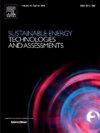From the idea to construction: Aspects of relevance of the optimized physical design of renewable hybrid power plants
IF 7.1
2区 工程技术
Q1 ENERGY & FUELS
Sustainable Energy Technologies and Assessments
Pub Date : 2025-05-09
DOI:10.1016/j.seta.2025.104325
引用次数: 0
Abstract
Renewable-based hybrid power plants (HPPs) combine different renewable technologies co-located and connected to a single grid connection point, offering better use of land and infrastructure. However, the integration of multiple technologies introduces new design challenges due to their physical interactions and organizational complexity. This paper is a critical literature review and original analysis of how the physical design of HPPs differs from single-technology facilities, with a particular focus on spatial layout optimization, electrical design, and macrositing of wind–PV hybrids. Using a Design Structure Matrix (DSM), a method for mapping interdependencies among system elements, we assess the physical interactions and their impact on system performance (such as the obvious shading of PV modules by wind turbines, and less obvious ones like increased risk of electrical surges). Additionally, we apply Actor-Network Theory (ANT), a socio-technical framework, to explore the social and organizational dynamics that influence design decisions in HPP development. Supported by outcomes of the interviews with industry practitioners, we outline value-driven design approaches that anticipate physical interactions, prioritize long-term performance, and leverage shared infrastructure, particularly when integrating adding PVs to wind farms. By connecting technical and socio-organizational perspectives, this work lays the ground for future holistic and interdisciplinary optimized HPP designs.

从理念到建设:可再生混合动力电厂优化物理设计的相关方面
基于可再生能源的混合发电厂(HPPs)将不同的可再生能源技术结合在一起,并连接到一个单一的电网连接点,从而更好地利用土地和基础设施。然而,多种技术的集成由于其物理交互和组织复杂性而引入了新的设计挑战。本文是一篇重要的文献综述和原始分析,分析了HPPs的物理设计与单一技术设施的不同之处,特别关注了空间布局优化、电气设计和风能-光伏混合动力的宏观定位。使用设计结构矩阵(DSM),一种映射系统元素之间相互依赖关系的方法,我们评估了物理相互作用及其对系统性能的影响(例如风力涡轮机对光伏模块的明显遮挡,以及不太明显的影响,如电涌风险增加)。此外,我们应用行动者网络理论(ANT),一个社会技术框架,探索影响HPP开发设计决策的社会和组织动态。根据对行业从业者的访谈结果,我们概述了价值驱动的设计方法,这些方法可以预测物理交互,优先考虑长期性能,并利用共享基础设施,特别是在将pv添加到风电场时。通过连接技术和社会组织的观点,这项工作为未来整体和跨学科优化的HPP设计奠定了基础。
本文章由计算机程序翻译,如有差异,请以英文原文为准。
求助全文
约1分钟内获得全文
求助全文
来源期刊

Sustainable Energy Technologies and Assessments
Energy-Renewable Energy, Sustainability and the Environment
CiteScore
12.70
自引率
12.50%
发文量
1091
期刊介绍:
Encouraging a transition to a sustainable energy future is imperative for our world. Technologies that enable this shift in various sectors like transportation, heating, and power systems are of utmost importance. Sustainable Energy Technologies and Assessments welcomes papers focusing on a range of aspects and levels of technological advancements in energy generation and utilization. The aim is to reduce the negative environmental impact associated with energy production and consumption, spanning from laboratory experiments to real-world applications in the commercial sector.
 求助内容:
求助内容: 应助结果提醒方式:
应助结果提醒方式:


